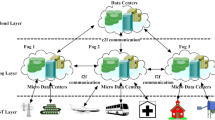Abstract
Wildfires are one of the most destructive disasters that have the ability of causing enormous loss to life and nature. Moreover, with its capability to spread abruptly over huge sectors of land, the loss to mankind is unimaginable. Global warming around the world has led to increase in the wildfires, therefore demands immediate attention of the concerned organizations. Conspicuously, this research aims at predicting the forest fires to minimize the loss and immediate actions in the direction of safety. Specifically, this research proposes an energy efficient IoT framework backed by fog-cloud computing technology for early prediction of wildfires. Initially, Jaccard similarity analysis is used to determine the redundant data acquired from IoT devices in real-time. This data is analyzed at fog computing layer and reduces multi-dimensional data to single value termed as Vulnerability Index. Finally, Artificial Neural Network is used to predict the vulnerability on forest region based on Wildfire Causing Parameters. ANN model is appended with Self-Organized mapping technique for effective visualization of geographical region with respect to wildfire vulnerability. Implementation simulation is performed over different datasets. Results are compared with several state-of-the-art techniques for overall performance estimation.









Similar content being viewed by others
Notes
Source: https://trends.google.com/trends/.
References
Facts + statistics: wildfires [online]. https://www.iii.org/fact-statistic/facts-statistics-wildfires. Accessed 1 Jan 2019
Wildfires rage in a changing climate—UNISDR [online]. https://www.unisdr.org/archive/49866. Accessed 1 Jan 2018
Sood, S.K., Mahajan, I.: A fog based healthcare framework for Chikungunya. IEEE Internet Things J. (2017). https://doi.org/10.1109/jiot.2017.2768407
Verma, P., Sood, S.K.: Fog-assisted IoT-enabled patient health monitoring in smart homes. IEEE Internet Things J. (2018). https://doi.org/10.1109/JIOT.2018.2803201
Baccarelli, E., Naranjo, P.G.V., Scarpiniti, M., Shojafar, M., Abawajy, J.H.: Fog of everything: energy-efficient networked computing architectures, research challenges, and a case study. IEEE Access 5, 9882–9910 (2017)
Yoon, I., Noh, D.K., Lee, D., Teguh, R., Honma, T., Shin, H.: Reliable wildfire monitoring with sparsely deployed wireless sensor networks. In: IEEE 26th International Conference on Advanced Information Networking and Applications (AINA), pp. 460–466, (2012)
Bolourchi, P., Uysal, S.: Forest fire detection in wireless sensor network using fuzzy logic. In: IEEE Fifth International Conference on Computational Intelligence, Communication Systems and Networks (CICSyN), pp. 83–87 (2013)
Trivedi, K., Srivastava, A.K.: An energy efficient framework for detection and monitoring of forest fire using mobile agent in wireless sensor networks. In: IEEE International Conference on Computational Intelligence and Computing Research (ICCIC), pp. 1–4 (2014)
Zhao, J., Liu, Y., Cheng, Y., Qiang, Y., Zhang, X.: Multisensor data fusion for wildfire warning. In: IEEE 10th International Conference on Mobile Ad-hoc and Sensor Networks (MSN), pp. 46–53 (2014)
Ulucinar, A.R., Korpeoglu, I., Cetin, A.E.: A Wi-Fi cluster based wireless sensor network application and deployment for wildfire detection. Int. J. Distrib. Sensor Netw. 10(10), 651957 (2014)
Kansal, A., Singh, Y., Kumar, N., Mohindru, V.: Detection of forest fires using machine learning technique: a perspective. In: IEEE Third International Conference on Image Information Processing (ICIIP), pp. 241–245 (2015)
Molina-Pico, A., Cuesta-Frau, D., Araujo, A., Alejandre, J., Rozas, A.: Forest monitoring and wildland early fire detection by a hierarchical wireless sensor network. J. Sens. (2016). https://doi.org/10.1155/2016/8325845
Mina, R., Ziade, Y.: Towards an optimal solution for environmental protection using wireless sensor networks. In: IEEE Third International Conference on Electrical, Electronics, Computer Engineering and their Applications (EECEA), pp. 120–125 (2016)
Saoudi, M., Bounceur, A., Euler, R., Kechadi, T.: Data mining techniques applied to wireless sensor networks for early forest fire detection. In: Proceedings of the International Conference on Internet of things and Cloud Computing, ACM (2016)
Abdullah, S., Masar, S., Bertalan, S., Coskun, A., Kale, I.: A wireless sensor network for early forest fire detection and monitoring as a decision factor in the context of a complex integrated emergency response system (2017)
Giuntini, F.T., Beder, D.M., Ueyama, J.: Exploiting self-organization and fault tolerance in wireless sensor networks: a case study on wildfire detection application. Int. J. Distrib. Sens. Netw. (2017). https://doi.org/10.1177/1550147717704120
Lin, H., Liu, X., Wang, X., Liu, Y.: A fuzzy inference and big data analysis algorithm for the prediction of forest fire based on rechargeable wireless sensor networks. Sustain. Comput. Inform. Syst. 18, 101–111 (2017)
Jan, M.A., Nanda, P., He, X., Liu, R.P.: A Sybil attack detection scheme for a forest wildfire monitoring application. Future Gener. Comput. Syst. 80, 613–626 (2018)
Toledo-Castro, J., Santos-González, I., Caballero-Gil, P., Hernández-Goya, C., Rodríguez-Pérez, N., Aguasca-Colomo, R.: Fuzzy-based forest fire prevention and detection by wireless sensor networks. In: 13th International Conference on Soft Computing Models in Industrial and Environmental Applications, Springer pp. 478–488 (2018)
Naranjo, P.G.V., Pooranian, Z., Shojafar, M., Conti, M., Buyya, R.: FOCAN: a Fog-supported smart city network architecture for management of applications in the internet of everything environments. J. Parallel Distrib. Comput. 132, 274–283 (2018)
Naranjo, P., Pooranian, Z., Shamshirband, S., Abawajy, J., Conti, M.: Fog over virtualized IoT: new opportunity for context-aware networked applications and a case study. Appl. Sci. 7(12), 1325 (2017)
Naranjo, P.G.V., Baccarelli, E., Scarpiniti, M.: Design and energy-efficient resource management of virtualized networked Fog architectures for the real-time support of IoT applications. J. Supercomput. 74(6), 2470–2507 (2018)
Bhatia, M., Sood, S.K.: An intelligent framework for workouts in gymnasium: M-Health perspective. Comput. Electr. Eng. 65, 292–309 (2018)
Author information
Authors and Affiliations
Corresponding author
Additional information
Publisher's Note
Springer Nature remains neutral with regard to jurisdictional claims in published maps and institutional affiliations.
Rights and permissions
About this article
Cite this article
Kaur, H., Sood, S.K. & Bhatia, M. Cloud-assisted green IoT-enabled comprehensive framework for wildfire monitoring. Cluster Comput 23, 1149–1162 (2020). https://doi.org/10.1007/s10586-019-02981-7
Received:
Revised:
Accepted:
Published:
Issue Date:
DOI: https://doi.org/10.1007/s10586-019-02981-7




